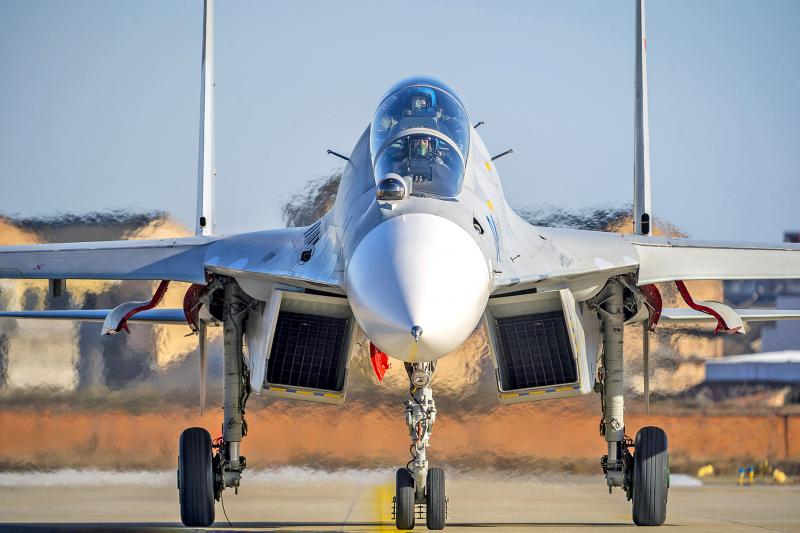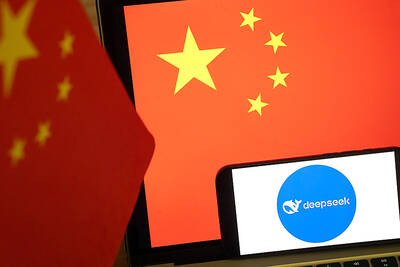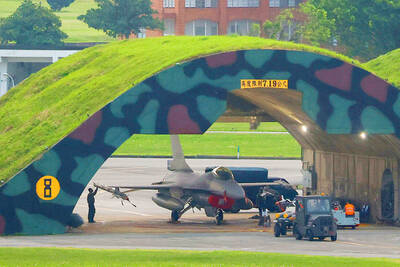China on Sunday sent 39 warplanes — mostly fighter jets — into Taiwan’s air defense identification zone (ADIZ), in its second-largest single-day incursion, the Ministry of National Defense said.
Thirteen warplanes entered the zone yesterday, it added.
The ministry late on Sunday said that the air force scrambled aircraft to broadcast warnings and deployed air-defense missile systems.

Photo: AP
The Chinese warplanes included 24 J-16 fighters — which experts say are among China’s favorite jets for testing Taiwan’s air defenses — 10 J-10s and one nuclear-capable H-6 bomber.
Yesterday’s incursion included eight J-16s and two J-16Ds — a jet introduced at an air show last year that is capable of neutralizing radar and communication systems, the ministry said.
On Oct. 4 last year, 56 aircraft entered the zone, the largest single-day incursion since the military began releasing such data in September 2020.
Last year, the ministry recorded 969 incursions by Chinese warplanes into Taiwan’s ADIZ, a database compiled by Agence France-Presse showed — more than double the number from 2020.
Yesterday, defense expert Lin Ying-yu (林穎佑) said that Beijing was trying to show its military might to world powers Japan and the US, which over the weekend concluded a round of drills off Okinawa.
Chieh Chung (揭仲), an associate research fellow at the National Policy Foundation in Taipei, agreed, saying that the incursions did not pose a serious threat to Taiwan’s security, but were intended to show Tokyo and Washington that Beijing would not back down from a show of force.
The incursions were also far away from Okinawa to ensure that China gets its message across without sparking a conflict, he said.
The Japan Maritime Self-Defense Force conducted joint exercises with the US Navy south of Okinawa from Monday last week to Saturday, NHK reported.
The latest joint exercise was apparently aimed at displaying their solid ties amid China’s increasing maritime activities, reports said.
Minister of Foreign Affairs Joseph Wu (吳釗燮) said in an interview with the Australian Strategic Policy Institute’s podcast The Bigger Picture that the international community should be vigilant of China as it seeks to expand its global influence.
Amid China’s nearly 1,000 incursions last year, Beijing continued to suppress Taiwan’s international presence, a ministry statement quoted Wu as saying.
China’s ambition apparently does not stop at Taiwan, Wu added, citing as an example the presence of Chinese surveillance ships near US-Australian military exercises in July last year.

MISINFORMATION: The generated content tends to adopt China’s official stance, such as ‘Taiwan is currently governed by the Chinese central government,’ the NSB said Five China-developed artificial intelligence (AI) language models exhibit cybersecurity risks and content biases, an inspection conducted by the National Security Bureau (NSB) showed. The five AI tools are: DeepSeek, Doubao (豆包), Yiyan (文心一言), Tongyi (通義千問) and Yuanbao (騰訊元寶), the bureau said, advising people to remain vigilant to protect personal data privacy and corporate business secrets. The NSB said it, in accordance with the National Intelligence Services Act (國家情報工作法), has reviewed international cybersecurity reports and intelligence, and coordinated with the Ministry of Justice Investigation Bureau and the National Police Agency’s Criminal Investigation Bureau to conduct an inspection of China-made AI language

BOOST IN CONFIDENCE: The sale sends a clear message of support for Taiwan and dispels rumors that US President Donald Trump ‘sold out’ the nation, an expert said The US government on Thursday announced a possible sale to Taiwan of fighter jet parts, which was estimated to cost about US$330 million, in a move that an expert said “sends a clear message of support for Taiwan” amid fears that Washington might be wavering in its attitude toward Taipei. It was the first announcement of an arms sale to Taiwan since US President Donald Trump returned to the White House earlier this year. The proposed package includes non-standard components, spare and repair parts, consumables and accessories, as well repair and return support for the F-16, C-130 and Indigenous Defense Fighter aircraft,

CHECKING BOUNDARIES: China wants to disrupt solidarity among democracies and test their red lines, but it is instead pushing nations to become more united, an expert said The US Department of State on Friday expressed deep concern over a Chinese public security agency’s investigation into Legislator Puma Shen (沈伯洋) for “secession.” “China’s actions threaten free speech and erode norms that have underpinned the cross-strait ‘status quo’ for decades,” a US Department of State spokesperson said. The Chongqing Municipal Public Security Bureau late last month listed Shen as “wanted” and launched an investigation into alleged “secession-related” criminal activities, including his founding of the Kuma Academy, a civil defense organization that prepares people for an invasion by China. The spokesperson said that the US was “deeply concerned” about the bureau investigating Shen

LIMITS: While China increases military pressure on Taiwan and expands its use of cognitive warfare, it is unwilling to target tech supply chains, the report said US and Taiwan military officials have warned that the Chinese People’s Liberation Army (PLA) could implement a blockade within “a matter of hours” and need only “minimal conversion time” prior to an attack on Taiwan, a report released on Tuesday by the US Senate’s China Economic and Security Review Commission said. “While there is no indication that China is planning an imminent attack, the United States and its allies and partners can no longer assume that a Taiwan contingency is a distant possibility for which they would have ample time to prepare,” it said. The commission made the comments in its annual